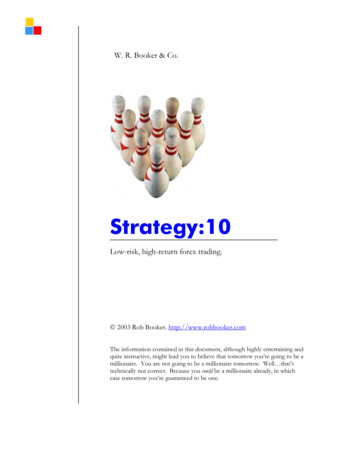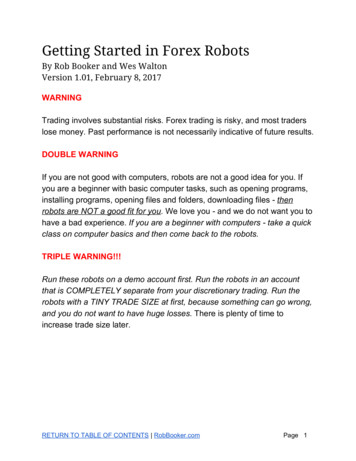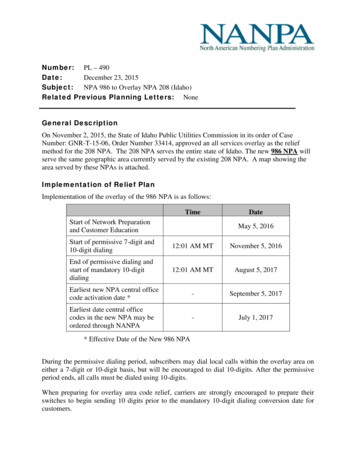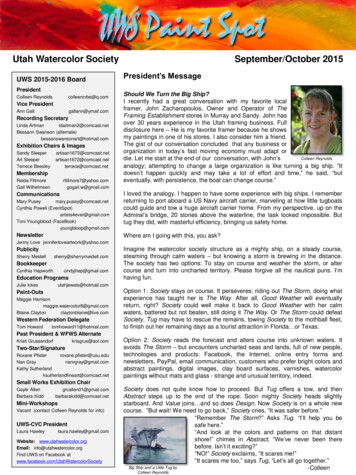
Transcription
www.robware.net/rvtoolsRob de Veij
RVTools 4.3.1 February 5, 2022IndexRVTools . 5vInfo. 6vCpu . 15vMemory . 18vDisk . 22vPartition . 27vNetwork . 30vCD . 34vUSB. 37vSnapshot . 40vTools . 43vSource . 50vRP . 52vCluster. 59vHost. 64vHBA . 69vNic . 70vSwitch . 72vPort . 75dvSwitch . 78dvPort . 82vSC VMK . 87vDatastore . 89vMultipath . 92vLicense . 94vFileInfo . 96vHealth . 97VMWARE VM Performance optimization considerations . 98DISK I/O . 98In-Memory VM performance . 98Health properties . 99Preferences. 100Communication . 101Page 2
RVTools 4.3.1 February 5, 2022Permissions. 101MB versus MiB. 102Deserialize error . 103Password encryption . 105Commandline parameters. 106Start RVTools with pass-through autentication . 106Start RVTools with userid password. 106Start RVTools with pass-through authentication, and export all to csv . 106Start RVTools with userid password, and export all to csv . 106Start RVTools with pass-through authentication, and export all to xlsx . 106Start RVTools with userid password, and export all to xlsx . 107Start RVTools with userid password, and export a single tab page to xlsx . 107Start RVTools with userid password, and export a single tab page to csv . 109Commandline switches . 111Powershell batch example . 112RVToolsMergeExcelFiles . 113Log4net properties . 114Version information . 115Version 4.3.1 (February 5, 2022) . 115Version 4.2.2 (December 29, 2021). 115Version 4.2.1 (December 4, 2021) . 115Version 4.1.4 (June 14, 2021) . 115Version 4.1.3 (April 11, 2021) . 115Version 4.1.2 (April 5, 2021) . 115Version 4.0.7 (December 19, 2020). 116Version 4.0.6 (August 29, 2020) . 116Version 4.0.4 (May 1, 2020) . 117Version 3.11.9 (May 26, 2019) . 117Version 3.11.8 (May 10, 2019) . 117Version 3.11.7 (March 15, 2019) . 117Version 3.11.6 (March 9, 2019) . 118Version 3.10.2 (June, 2018) . 118Version 3.10 (February, 2018) . 118Version 3.9.5 (April, 2017) . 119Page 3
RVTools 4.3.1 February 5, 2022Version 3.9.3 (March, 2017) . 119Version 3.9 (February, 2017) . 119Version 3.8.6 (July, 2016) . 120Version 3.8 (March, 2016) . 120Version 3.7 (March, 2015) . 121Version 3.6 (February, 2014) . 121Version 3.5 (March, 2013) . 122Version 3.4 (September, 2012) . 122Version 3.3 (April, 2012) . 122Version 3.2 (October, 2011) . 123Version 3.1 (April, 2011) . 123Version 3.0 (January, 2011) . 123Version 2.9.5 (September, 2010) . 124Version 2.9.1 (May 4, 2010) . 124Version 2.9.1 (May 4, 2010) . 124Version 2.9 (April 2010) . 124Version 2.8.1 (February 2010) . 124Version 2.8 (January 2010) . 125Version 2.7.3 (December 19, 2009). 125Version 2.7.1 (November 19, 2009) . 125Version 2.7 (November, 2009) . 125Version 2.6 (September, 2009) . 126Version 2.5.5 (June 27, 2009) . 126Version 2.5.1 (April 15, 2009) . 126Version 2.5 (April 2009) . 127Version 2.4.1 (March 18, 2009) . 127Version 2.4 (March 2009) . 127Version 2.3.1 (February 11, 2009) . 128Version 2.3 (February 2009) . 128Version 2.2 (January 2009) . 128Version 2.1 (November 2008) . 129Version 2.0 (October 2008) . 129Version 1.1 (May 2008) . 129Version 1.0 (April 2008) . 129Page 4
RVTools 4.3.1 February 5, 2022RVToolsRVTools is a Windows .NET 4.6.1 application which uses VMware vSphere ManagementSDK 7.0 and CIS REST API to display information about your virtual environments.Interacting with VirtualCenter 4.x, ESX Server 4.x, VirtualCenter 5.x, ESX Server 5.x,VirtualCenter 6.x, ESX Server 6.x, VirtualCenter 7.0 and ESX server 7.0 RVTools is ableto list information about VMs, CPU, Memory, Disks, Partitions, Network, CD drives, USBdevices. Snapshots, VMware tools, vCenter server,Resource pools, Clusters, ESX hosts,HBAs, Nics, Switches, Ports, Distributed Switches, Distributed Ports, Service consoles, VMKernels, Datastores, multipath info, license info and health checks.The information can be exported to csv and xlsx file(s). With a xlsx merge utility it’spossible to merge muliple vCenter xlsx reports to a single xlsx report.Page 5
RVTools 4.3.1 February 5, 2022vInfoThe “vInfo” tab displays for each virtual machine the virtual machine name, powerstate,template, SRM Placeholder, config status, DNS name, connection state, guest state,heartbeat, consolidation needed, power on date / time, suspend date / time, creationdate / time, change version, number of cpu’s, latency-sensitivity, amount of memory,number of nics, number of virtual disks, min Required EVC Mode Key, disk.EnableUUID,CBT, primary IP address, connected networks, number of monitors, video Ram KiB,resource pool, folder name, vApp name, DAS protection, fault tolerance State, faulttolerance latency status, fault tolerance band width, fault tolerance secondary latency,provisioned storage, used storage, unshared storage, HA restart priority, HA isolationresponse, HA VM Monitoring, Cluster rule(s), Cluster rule name(s), install Boot Required,Boot delay, Boot retry delay, Boot retry enabled, Boot BIOS setup, Firmware, HWversion, HW upgrade status, HW upgrade policy, HW target, configuration path, logdirectory, snapshot directory, suspend directory, annotation, custom fields, datacentername, cluster name, ESX host name, operating system name according to the config file,operating system name acoording to the VMware tools, virtual machine ID, VM UUID, VISDK server type, VI SDK API version, virtual machine tags, VI SDK Server and VI SDKUUID.VMDisplay name of the virtual machine.PowerstateThis column list the powerstate for a virtual machine: poweredOn, poweredOff, orsuspended. This column does not model substates, such as when a task is running tochange the virtual machine state. If the virtual machine is in a state with a task inprogress, it transitions to a new state when the task completes. For example, a virtualmachine continues to be in the poweredOn state while a suspend task is running, andchanges to the suspended state once the task finishes.NAMEDESCRIPTIONpoweredOffThe virtual machine is currently powered off.poweredOnThe virtual machine is currently powered on.suspendedThe virtual machine is currently suspended.Page 6
RVTools 4.3.1 February 5, 2022TemplateColumn which specifies if this is a template or not.SRM PlaceholderColumn which specifies if this is a SRM placeholder or not.Config statusThe config status indicates whether or not the system has detected a configuration issueinvolving this VM. The meanings of the config status values are: red: A problem has been detected involving the entity.yellow: A problem is about to occur or a transient condition has occurred (Forexample, reconfigure fail-over policy).green: No configuration issues have been detected.gray: The configuration status of the entity is not being monitored.A green status indicates only that a problem has not been detected; it is not a guaranteethat the entity is problem-free. Config issues are displayed on the vHealth tab page.DNS NameDNS name of the guest operating system, if known.Connection stateIndicates whether or not the virtual machine is available for management.NAMEDESCRIPTIONconnectedThe server has access to the virtual machine.disconnectedThe server is currently disconnected from the virtual machine, since its hostis disconnected. See general comment for this enumerated type for moredetails.inaccessibleOne or more of the virtual machine configuration files are inaccessible. Forexample, this can be due to transient disk failures. In this case, noconfiguration can be returned for a virtual machine.invalidThe virtual machine configuration format is invalid. Thus, it is accessible ondisk, but corrupted in a way that does not allow the server to read thecontent. In this case, no configuration can be returned for a virtual machine.orphanedThe virtual machine is no longer registered on the host it is associated with.For example, a virtual machine that is unregistered or deleted directly on ahost managed by VirtualCenter shows up in this state.Guest stateOperation mode of guest operating system. One of:NAMEDESCRIPTIONrunningGuest is running normally.shuttingdownGuest has a pending shutdown command.resettingGuest has a pending reset commandPage 7
RVTools 4.3.1 February 5, 2022standbyGuest has a pending standby command.notrunningGuest is not running.unknownGuest information is not available.HeartbeatThe guest heartbeat. The heartbeat status is classified as:NAMEDESCRIPTIONgrayThe status is unknown.greenThe entity is OK.redThe entity definitely has a problem.yellowThe entity might have a problem.Consolidation NeededWhether any disk of the virtual machine requires consolidation. This can happen forexample when a snapshot is deleted but its associated disk is not committed back to thebase disk. Since vSphere API 5.0PowerOnThe timestamp when the virtual machine was most recently powered on.This property is updated when the virtual machine is powered on from the poweredOffstate, and is cleared when the virtual machine is powered off. This property is notupdated when a virtual machine is resumed from a suspended state.Suspend timeThe timestamp when the virtual machine was most recently suspended.This property is updated every time the virtual machine is suspended.Creation dateCreation date of a virtual machine represented in DateTime format.This property is populated by the vCenter Server with the date and time of creation ofthe virtual machine.Change versionThe changeVersion is a unique identifier for a given version of the configuration. Eachchange to the configuration updates this value. This is typically implemented as an everincreasing count or a time-stamp. However, a client should always treat this as anopaque string.CPU’sNumber of processors in the virtual machine.Latency-sensitivityThe latency-sensitivity of the virtual machine.Page 8
RVTools 4.3.1 February 5, 2022MemoryMemory size of the virtual machine, in megabytes.NIC’sNumber of virtual network adapters. When RVTools is “connected” to the Virtual Centerserver this column has a value. When connected to an ESX host this column is “null”!DisksNumber of virtual disks. When RVTools is “connected” to the Virtual Center server thiscolumn has a value. When connected to an ESX host this column is “null”!Min Required EVC Mode KeyFor a powered-on or suspended virtual machine in a cluster with Enhanced VMotionCompatibility (EVC) enabled, this identifies the least-featured EVC mode (among thosefor the appropriate CPU vendor) that could admit the virtual machine. See EVCMode.Until vSphere 6.5, this property will be unset if the virtual machine is powered off or isnot in an EVC cluster.This property may be used as a general indicator of the CPU feature baseline currently inuse by the virtual machine. However, the virtual machine may be suppressing some ofthe features present in the CPU feature baseline of the indicated mode, either explicitly(in the virtual machine's configured cpuFeatureMask) or implicitly (in the default masksfor the GuestOsDescriptor appropriate for the virtual machine's configured guest OS).disk.EnableUUIDdisk.EnableUUID value. True Application-Consistent, False Crash-ConsistentCBTChanged Block Tracking (CBT) BooleanPrimary IP AddressPrimary IP address assigned to the guest operating system, if known.Network #1 to #8Connected networks.Num MonitorsIndicates the number of supported monitors. The number of displays X the maximumresolution of each display is bounded by the video RAM size of the virtual video card.Video Ram KiBThe size of the framebuffer for a virtual machine.Resource pool nameThe current resource pool name that specifies resource allocation for this virtual machine.Page 9
RVTools 4.3.1 February 5, 2022FolderThe name of the folder where the VM is placed. By default not visible because it’s aperformance killer. You can change the default behavior by changing the preferences.See menu, Edit, PreferencesvAppThe vApp name. By default not visible because it’s a performance killer. You can changethe default behavior by changing the preferences. See menu, Edit, PreferencesDAS ProtectionWhether vSphere HA is protecting a virtual machine (VM).FT stateThe fault tolerance state of the virtual machine.FT LatencyThe latency status of the fault tolerance VM. ftLatencyStatus is determined by the valueof ftSecondaryLatency. ftLatencyStatus is: green, if ftSecondaryLatency is less than orequal to 2 seconds; yellow, if ftSecondaryLatency is greater than 2 seconds, and lessthan or equal to 6 seconds; red, if ftSecondaryLatency is greater than 6 seconds; gray, ifftSecondaryLatency is unknown.FT BandwidthThe network bandwidth used for logging between the primary and secondary faulttolerance VMs. The unit is kilobytes per second.FT sec. LatencyThe amount of time in wallclock that the VCPU of the secondary fault tolerance VM isbehind the VCPU of the primary VM. The unit is millisecond.Provisioned MiBTotal storage space, in MiB, committed to this virtual machine across all datastores.Essentially an aggregate of the property commited across all datastores that this virtualmachine is located on.In use MiBStorage in use, space in MiBs, used by this virtual machine on all datastores.Page10
RVTools 4.3.1 February 5, 2022Unshared MiBTotal storage space, in MiB, occupied by the virtual machine across all datastores, that isnot shared with any other virtual machine.HA Restart PriorityRestart priority for a virtual machine. If not specified at either the cluster level or thevirtual machine level, this will default to l machines with this priority use the default restart prioritydefined for the cluster that contains this virtual machine.disabledvSphere HA is disabled for this virtual machine.highVirtual machines with this priority have a higher chance of powering onafter a failure if there is insufficient capacity on hosts to meet all virtualmachine needs.lowVirtual machines with this priority have a lower chance of powering onafter a failure if there is insufficient capacity on hosts to meet all virtualmachine needs.mediumVirtual machines with this priority have an intermediate chance ofpowering on after a failure if there is insufficient capacity on hosts tomeet all virtual machine needs.HA Isolation ResponseIndicates whether or not the virtual machine should be powered off if a host determinesthat it is isolated from the rest of the compute resource. If not specified at either thecluster level or the virtual machine level, this will default to e the default isolation reponse defined for the cluster thatcontains this virtual machine.noneDo not power off the virtual machine in the event of a host networkisolation.powerOffPower off the virtual machine in the event of a host networkisolation.shutdownShut down the virtual machine guest operating system in the eventof a host network isolation. If the guest operating system fails toshutdown within five minutes, HA will initiate a forced power off.When you use the shutdown isolation response, failover can takelonger (compared to the powerOff response) because the virtualmachine cannot fail over until it is shutdown.HA VM MonitoringLevel of HA Virtual Machine Health Monitoring Service. You can monitor both guest andapplication heartbeats, guest heartbeats only, or you can disable the serviceCluster rulesThis value will show you the affinity and anti-affinity rules which are defined for this VM.Page11
RVTools 4.3.1 February 5, 2022Cluster rule namesThis value will show you the name(s) of the affinity and anti-affinity rules which aredefined for this VM.Boot requiredSpecifies whether the VM needs an initial boot before the deployment is complete.Boot delayDelay in milliseconds before starting the boot sequence. The boot delay specifies a timeinterval between virtual machine power on or restart and the beginning of the bootsequence.Boot retry delayDelay in milliseconds before a boot retry. The boot retry delay specifies a time intervalbetween virtual machine boot failure and the subsequent attempt to boot again. Thevirtual machine uses this value only if bootRetryEnabled is true.Boot retry enabledIf set to true, a virtual machine that fails to boot will try again after the bootRetryDelaytime period has expired. When false, the virtual machine waits indefinitely for you toinitiate boot retry.Boot BIOS setupIf set to true, the virtual machine automatically enters BIOS setup the next time it boots.The virtual machine resets this flag to false so that subsequent boots proceed normally.FirmwareInformation about firmware type for this Virtual Machine. Possible values are:biosBIOS firmwareefiExtensible Firmware InterfaceHW versionVirtual hardware version.HW upgrade statusStatus for last attempt to run scheduled hardware upgrade.failednonependingsuccessUpgrade failed.No scheduled upgrade ever happened.Upgrade is scheduled, but was not run yet.Upgrade succeeded.HW upgrade policyScheduled hardware upgrade policy setting for the virtual machine.Page12
RVTools 4.3.1 February 5, 2022HW targetKey for target hardware version to be used on next scheduled upgrade.PathPath name to the configuration file for the virtual machine.Log directoryDirectory to store the log files for the virtual machine. If not specified, this defaults to thesame directory as the configuration file.Snapshot directoryPath name of the directory that holds suspend and snapshot files belonging to the virtualmachine. Prior to vSphere 5.0, this directory also holds snapshot redo files. Starting withvSphere 5.0, the redo files will stay in the same directory as the snapshotted disk, thusthis directory will no longer hold the snapshot redo files. This path name defaults to thesame directory as the configuration file.Suspend directorySome products allow the suspend directory to be different than the snapshot directory.On products where this is not possible, setting of this property is ignored.AnnotationDescription for the virtual machine.Custom FieldsThe custom fields which you have defined.DatacenterThe name of the datacenter where the VM is running.ClusterThe name of the cluster where the VM is running.HostThe host that is responsible for running a virtual machine. This property is null when thevirtual machine is not running and is not assigned to run on a particular host.OS according to the configuration fileThis is the full name of the guest operating system for the virtual machine according tothe configuration file.OS according to the VMware ToolsThis is the full name of the guest operating system for t
The timestamp when the virtual machine was most recently powered on. This property is updated when the virtual machine is powered on from the poweredOff state, and is cleared when the virtual machine is powered off. This property is not updated when a virtual machine is resumed from a suspended state. Suspend time










